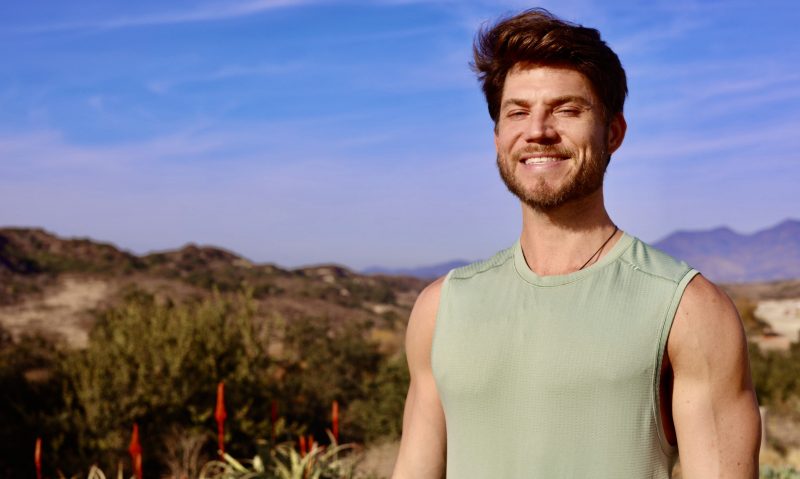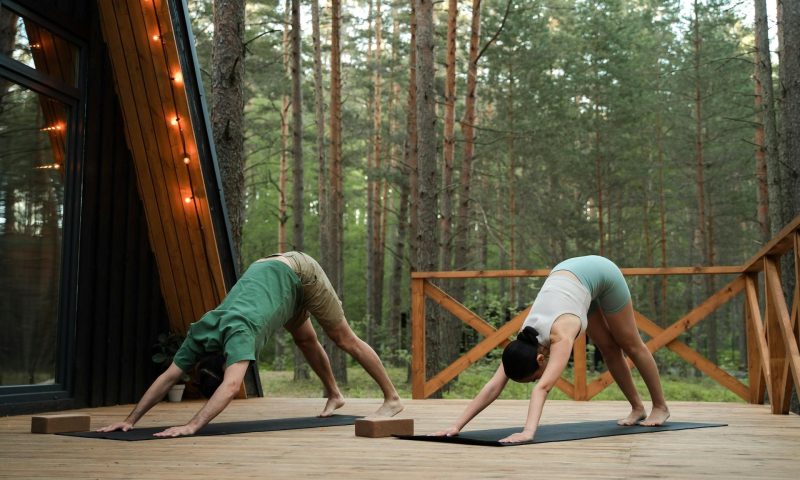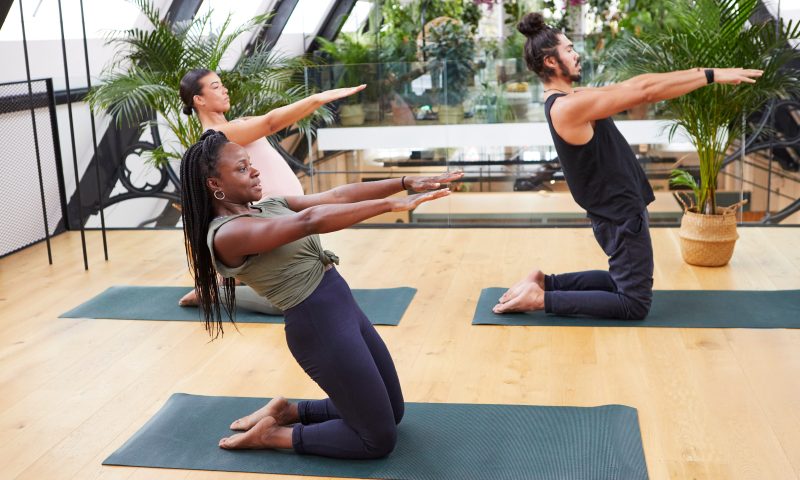I honestly didn’t understand what all the fuss was about until I tried yoga. Only then did I understand how good it feels to move and stretch my muscles in so many different ways. Dealing with the challenges of a painful autoimmune bone disease called ankylosing spondylitis, I was searching for ways to help relieve some of that inflammation, pain, and stiffness in my spine and SI joints — enter the power of yoga.
Along with nutrition and certain other lifestyle changes, yoga has made a big impact on my overall wellness and my pain levels. Sometimes, I’ll randomly break into a yoga pose because it just feels good. My body thanks me even for a simple sun salutation because our bodies were made to move. Over time, I can feel myself getting stronger and more flexible.
Yoga for strength training

Some people think you have to pump serious iron and lift weights in the gym to build muscle strength, and that yoga is mostly for stretching and flexibility. However, research shows that yoga is an effective practice for boosting muscle strength. If pumping iron in the weight room isn’t your thing, you’ll be pleased to know you can strengthen your muscles with yoga. That being said, the best results come from a well-rounded workout routine that also involves adding weights, especially if bulking up those muscles and maximizing strength is your goal.
We tapped into the immense knowledge and expertise of Master Trainer and experienced yogi Elisei Rusu to learn more about how to use yoga as a vehicle for strength training. Rusu is a Master Trainer for YogaSix and a registered yoga teacher with a certification from Alliance, where teachers must have thousands of hours of experience. Rusu certainly knows a thing or two about harnessing the power of yoga.
Interview with Master Yoga Trainer Elisei Rusu

The Manual: When did you first start doing yoga? Could you share the beginning of your yoga journey with our readers?
Elisei Rusu: I found yoga during a difficult period in my life. I just got out of a long-term relationship that was more like a marriage. My dad was dying from colon cancer, and I was teaching English in China at a kindergarten. That was my way of escaping my problems at home.
Because fitness has always been a part of my life, I stumbled across a yoga class at the gym I was working out at in Hangzhou, China. The whole class was in Chinese, so all I could really do was mirror the teacher. But just that alone, with no way of understanding her, sparked an interest in me. I knew there was something to this yoga thing because I always left feeling calm and centered. It was a high in all the lows.
TM: What are the most valuable benefits of yoga for general health and wellness?
Elisei Rusu: Yoga offers a wide range of benefits for general health and wellness, touching on physical, mental, and emotional well-being. It truly is a powerful medicine. Once yoga became a staple in my life, I started to notice shifts in my mindset. I no longer needed to escape my problems because I was able to be present with the discomfort that life challenges you with.
When you’re practicing yoga, you have to sit in poses that are challenging, sometimes in high heat; putting yourself through this practice allows you to deal with life off your mat. When you’re in tune with your body, you begin to treat it with reverence. I went through a cleansing period where I allowed only the things that brought me health and wellness through my diet, being intentional with time in nature, and cutting back on smoking and drinking. Now, I’m able to find a balance because of my yoga practice.

TM: How did you study and train your body to become a Master Yoga Trainer for YogaSix, and why did you decide to become a Master Trainer?
Elisei Rusu: I wouldn’t call myself a master trainer; there’s nothing to master in Yoga. There is always new research or variation of poses. Even after teaching thousands of classes, I feel like I’m just scratching the surface. Yoga is a lifelong path of learning, awareness, and self-inquiry. There’s always more to discover within yourself.
I choose to become a full-time teacher because I believe in the power of yoga and its ability to transform your life. Seeing these transformations in my students is what keeps my love and curiosity of yoga alive.
TM: Research shows that yoga is effective for boosting strength and targeting both upper and lower limbs. What are the best types of yoga for strength training?
Elisei Rusu: I teach power vinyasa classes, which combine flowing sequences with strength-building poses like chaturanga, planks, and warrior variations. This type of yoga is a full-body experience. You can also find yoga sculpt classes that add weights to the practice, making it more of a HIIT-style workout with yoga as a warm-up and cool-down. Adding weight is key if you’re looking to build strength.

TM: Could you share more about the science behind yoga as a vehicle for strength training?
Elisei Rusu: Yoga involves both concentric (muscle shortening, like rising from a lunge) and eccentric (muscle lengthening, like lowering in chaturanga) contractions:
- These are crucial for building functional strength and joint stability.
- Eccentric movement is especially effective at building strength while protecting joints and tendons.
Once you have this stability and body awareness, you’ll be able to find a deeper range of motion when you’re lifting weights.
TM: What are your top two or three yoga poses to build lower body power?
Elisei Rusu: If you ask a yogi their least favorite pose, most likely, chair pose will be mentioned. Chair is effective at building lower body power. It targets quads, glutes, hamstrings, and even calves. It builds isometric strength and core engagement and is great for endurance. You can add reps, pulses, or hold variations to increase the challenge. This one is top for me!
Crescent lunge is a close second. It strengthens the glutes, hamstrings, quads, and hip flexors, stabilizes the pelvis, and builds control in the legs and core. It’s also a great transitional pose and a staple in any yoga sequence because of its effectiveness in building lower body power.

TM: What are your top two or three yoga poses to build upper body power?
Elisei Rusu: Chaturanga Dandasana takes the cake here! It’s like a yogic push-up, targeting the chest, triceps, shoulders, and core. It builds raw pushing power and shoulder stability and strengthens the eccentric (lowering) phase, which is essential for control and injury prevention.
Dolphin Pose is a beast for the shoulders, upper back, arms, and core. It builds power and stability needed for inversions and arm balances, and acts like an overhead press using your own bodyweight.
TM: Could you share your top two or three yoga poses for promoting core strength and stability?
Elisei Rusu: Boat Pose directly targets the rectus abdominis (front abs), hip flexors, and deep core stabilizers. It builds isometric strength in the full core. I like it because it can be modified or progressed easily (knees bent or straight, arms reaching or overhead).
I also love Vasisthasana (Side plank) because it is fun to say and targets obliques, deep stabilizers, shoulder girdles, and glutes. It builds unilateral strength and prevents imbalance. It also enhances balance and coordination through core control.

TM: How many times per week would you advise practicing yoga if you really want to develop full-body strength? How long would each session be in your weekly strength-building plan?
Elisei Rusu: I would recommend practicing at least 3x 60-minute sessions a week. Of course, this depends on your schedule and how much time you can carve out for yourself. Know that you will not only build strength but also gain mental clarity and find stress release with each practice. It’s a whole mind-body experience.
TM: Does it matter what time of day you do yoga for strength training?
Elisei Rusu: The best time is the time you can stick to consistently when you feel energized and focused. That might be mornings if you love structure and starting strong, or afternoons/evenings if you feel stronger later in the day. I personally like to practice in the morning. There’s something about starting your day with a clear mental space that flows into the rest of your day.

TM: In addition to yoga, do you advise incorporating other types of exercise into a workout schedule to optimize muscle strength?
Elisei Rusu: Yoga builds strength, mobility, and flexibility, but it can sometimes lack the intensity needed to maximize muscle size and power. Incorporating weight training, using dumbbells, barbells, or resistance bands, can specifically target and increase muscle mass in key areas. I supplement my yoga practice with four gym sessions a week, where I lift to target the major muscle groups.
TM: What are your top tips for beginners to get started incorporating these practices into their schedule?
Elisei Rusu: Start off small! Commit to one class a week. And try out different teachers. Each teacher has their own unique style, music, and cueing. You can totally vibe with one teacher and experience confusion with another. Try out different styles until you find one that you really like. Yoga is a powerful medicine that will do wonders for your body. Stick with it; it’s the fountain of youth.



